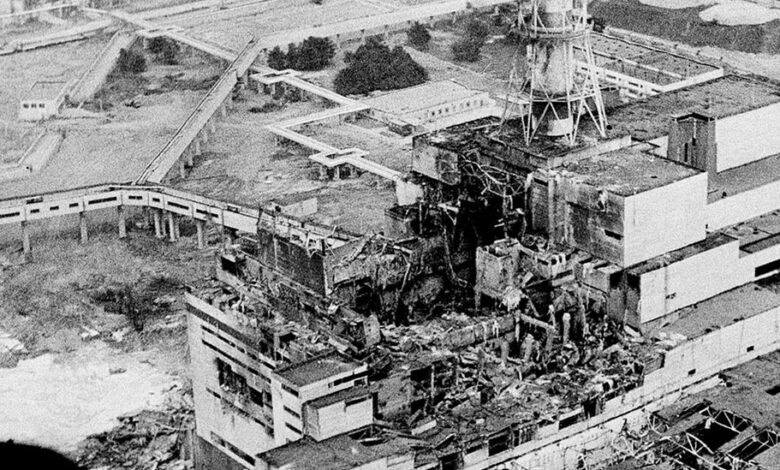For Chernobyl Survivors, New Ukraine Nuclear Risk Stirs Dread

For Valentyna Tkachenko, mere mention of the Zaporizhzhia power plant triggers tears of anguish. Like many around the world, she has been anxiously following the news about the fighting around the nuclear plant in southern Ukraine — but unlike most, she has seen a nuclear disaster unfold around her firsthand.
Ms. Tkachenko was 12 in 1986 when she spotted a glow at the Chernobyl power plant from her home in the village of Lubyanka, about 20 miles away. The plant in northern Ukraine had exploded, and was on fire.
She and her family were evacuated, and never returned to their home. Her aunt later died of cancer, an illness that Ms. Tkachenko said had affected many from her village. Ms. Tkachenko’s thick blond hair — “such a braid that no hairpin could cope with it,” she recalls — grew thinner, and then started falling out.
And now fear is growing about another nuclear plant in Ukraine, as Russian and Ukrainian forces exchange fire near it.
“Words cannot express what a disaster this would be for people,” Ms. Tkachenko said in a phone call from her house in Pogreby, a village near Kyiv where Chernobyl evacuees were resettled. Growing up there, she said people in the surrounding area were afraid of her, as if she bore some kind of disease.
“We have to shout to the whole world so that the history of Chernobyl does not repeat itself” she said.
The danger of a disaster at the Zaporizhzhia power plant has resonated across the world, raising the specter of unknown calamity.
For Chernobyl survivors, however, at least some of the consequences are all too well known. They recall the precise features: the ghost towns, the contaminated milk, the fear and the disease.
The Chernobyl accident, generally regarded as the worst nuclear disaster in history, displaced hundreds of thousands of people, emptied villages and poisoned swaths of Ukrainian, Belarusian and Russian land.
Experts say Zaporizhzhia may pose less danger because the containment structures around the reactor will probably be able to stop any release of radiation; Chernobyl did not have the structures. The reactors at Zaporizhzhia also have separate water circuits to cool the reactor and to produce steam.
Still, the threat remains significant.
If a shelling or other attack caused a fire to break out at the power transformers and the electric network failed, that could result in a breakdown of the plant’s cooling system and lead to a meltdown, said Edwin Lyman, a nuclear power expert at the Union of Concerned Scientists, a private group in Cambridge, Mass.
Dmytro Orlov, the mayor of Enerhodar, the city where the plant is located, said Saturday that it had received a delivery of 25,000 tablets of potassium iodide, a drug that prevents the thyroid gland from taking up radioactive forms of iodine.
From a scientific perspective, the health consequences of Chernobyl are uncertain in terms of just how many deaths may ultimately be attributable to the disaster.
What is generally undisputed is that dozens of people died of acute radiation syndrome as a direct result of the disaster. And according to the United Nations, in the first 30 years after the explosion, about 5,000 cases of thyroid cancer in children and teenagers in Ukraine, Russia and Belarus were related to radiation exposure.
U.N. experts have also estimated that radiation could cause up to about 4,000 eventual deaths among the higher-exposed Chernobyl populations, such as emergency workers, evacuees and residents of the most contaminated areas.
Now, the Chernobyl disaster is casting a shadow over Zaporizhzhia, and the broader region.
“We do not want another Chernobyl,” Turkey’s president, Recep Tayyip Erdogan, said Friday.
In March, after the plant first came under attack, Ukraine’s president, Volodymyr Zelensky, had a dire warning: “You know the word ‘Chernobyl,’” he said.
Some survivors of that disaster cannot even bring themselves to say that word, all these years later, and won’t talk about it. Others say they are still dealing with the consequences.
Andriy Kulish, a former Soviet military officer, said that after the explosion, he was ordered to clean the roof of Chernobyl’s Reactor 3. The same evening, he recalls, he felt dizzy and nauseated, and vomited and passed out. Doctors at the Kyiv hospital, where he said servicemen with radiation exposure occupied two floors of the neurological department, said he had sustained a high dose of radiation.
Over the years, his thyroid gland doubled in size, he said. Then he developed chronic heart disease and severe physical weakness, that led him to resign as a senior officer of the Ukrainian Defense Ministry and then from the civilian job he got after. He said most of the soldiers from his company had fallen ill or died.
“I know better than others what high radiation is,” he wrote in an email.
Natalia Kuziomko recalls being evacuated from her village of Illintsi when she was 9, and returning there over the years only for brief visits. “When I visited my native village, my heart ached all the way,” she said.
Her mother stayed behind for a week to try to evacuate the pigs from her farm, and later died of ovarian cancer.
“Does Russia not understand that they are creating such a danger?” Ms. Kuziomko asked. “This is very scary.”
She has stocked up on iodine tablets, again.